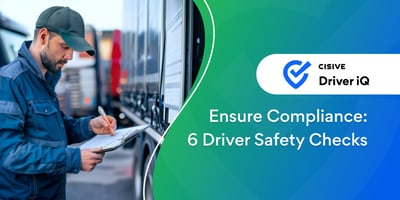

Keeping your fleet compliant and your drivers safe is a critical element of your fleet management....

Hiring a commercial driver is more than just filling a seat in the cab of a truck. Every time a commercial motor vehicle hits the road, the company that owns it is placing its trust—and liability—into the hands of a CDL holder. That trust must be earned and verified, not assumed. One of the most effective ways to protect your organization, reduce risk, and stay compliant is through thorough CDL license verification.
From preventing accidents to avoiding costly violations, verifying a commercial driver’s license (CDL) is critical. It’s not just about what a candidate says on paper. It’s about making sure they have the proper credentials, a clean safety record, and the physical ability to operate a vehicle legally and safely. Without the right processes in place, motor carriers can find themselves liable for preventable disasters.
Key Takeaways:Here are the key things you need to know about CDL license verification:
|
A Commercial Driver’s License (CDL) is a specialized license required to operate certain types of vehicles, such as tractor-trailers, tankers, and passenger buses. This license is regulated at the federal level by the Federal Motor Carrier Safety Administration (FMCSA) and is enforced in conjunction with each state's Department of Motor Vehicles (DMV).
There are three primary classes of CDL:
The Commercial Driver's License Information System (CDLIS) is a nationwide database that allows employers and state licensing agencies to track and share information on commercial driver licenses across all 51 U.S. jurisdictions. A CDLIS report provides a summary of a driver’s CDL history, including the states where a license has been held, current license status, and any disqualifications. It's a vital first step in CDL license verification, helping motor carriers uncover past violations and ensure a driver holds only one valid license.
A CDL background check typically includes a review of the driver's motor vehicle record (MVR), verification of the commercial driver’s license, employment history, and any drug and alcohol testing results. These checks are essential for ensuring compliance with federal motor carrier safety regulations under 49 CFR, and for confirming that each CDL holder is qualified to safely operate a commercial motor vehicle.
Employers must also verify a current medical examination certificate and screen for any disqualifying criminal history or driving violations. These components form the foundation of CDL background check requirements, helping motor carriers evaluate both the legal and safety qualifications of every driver they consider bringing onto their fleet.
Each CDL is issued by a specific state, but drivers may move across state lines for work. Employers need to verify the issuing state and confirm that the license is valid and current. This involves searching through the Commercial Driver’s License Information System (CDLIS), which connects all 51 jurisdictions (50 states plus D.C.).
While the CDLIS provides a nationwide snapshot, certain details must be confirmed with the issuing state’s DMV, such as suspensions, revocations, and endorsements. Because procedures vary, familiarity with state-specific verification processes is essential.
The most critical part of CDL license verification is checking whether a license is active, expired, suspended, or revoked. Employers must confirm that the driver is legally allowed to operate a commercial motor vehicle. Details such as the license number, class, expiration date, endorsements, and restrictions should be checked thoroughly.
A lapse in a driver’s CDL status—especially after hire—can create major liability. Routine verification is key to ensuring ongoing compliance.
A driver’s safety history is a strong predictor of future behavior. Employers must check for traffic violations, DUI convictions, failed drug tests, and disqualifying offenses under 49 CFR Part 383 and Part 391. Violations may be found through MVRs, CDLIS, and the FMCSA Drug & Alcohol Clearinghouse, which provides real-time data on drivers who fail drug or alcohol tests or refuse testing.
By identifying high-risk CDL drivers during the hiring process, companies can prevent future accidents, litigation, and damage to their brand.
CDLs are a foundational requirement for promoting road safety and preventing unqualified drivers from operating heavy vehicles. Employers have a duty to ensure that their CDL holders are trained, licensed, and in good standing with both federal and state agencies.
DOT driver requirements set the foundation for who can operate a commercial motor vehicle, detailing physical, legal, and performance standards that all CDL holders must meet. Understanding these DOT driver requirements is essential for staying compliant and maintaining a safe fleet.
Under 49 CFR, the FMCSA requires all motor carriers to verify that CDL drivers meet minimum standards. This includes:
For example, 49 CFR Part 391.23 requires employers to obtain and review a driver’s MVR from every state where they held a license in the past three years. These checks must be conducted prior to hire and annually thereafter.
While the FMCSA creates the framework, each state can add its own regulations. For instance, California mandates enrollment in the Employer Pull Notice (EPN) program, which automatically notifies employers of changes in a driver's record.
Other states may require additional background checks, training documentation, or shorter timelines for submitting new hire driver data. Employers must stay informed to ensure compliance.
Many companies focus on pre-hire background checks—but verification shouldn’t stop once a driver is on the payroll. A commercial driver license (CDL) can be suspended or revoked after hiring, and if that change goes undetected, the company could be liable for any incidents involving that driver.
That’s why ongoing CDL license verification—monthly or real-time—is essential for compliance and risk mitigation.

Even with strong hiring practices in place, verifying a commercial driver’s license comes with its own set of complications. From navigating multi-state systems to interpreting fragmented data, the CDL verification process is rarely straightforward. Employers must be aware of these common roadblocks to maintain compliance and ensure the safety of their fleet.
Employers often ask, how long does a CDL background check take? The answer varies depending on how many states are involved, how quickly records can be pulled, and whether manual verifications are required. Lengthy turnaround times can delay onboarding, create scheduling headaches, and open compliance gaps—especially when fleet operations are running on tight timelines. Working with a background screening partner, especially one that supports automated screenings in the flow of work, can significantly reduce the timeline.
CDL-related information is often spread across multiple databases, such as the CDLIS, state DMV records, MVRs, and the Drug & Alcohol Clearinghouse. Discrepancies between these systems can lead to incomplete or conflicting reports, making it difficult to get a single, accurate view of a driver's eligibility and history.
Without automation, HR and compliance teams are forced to manually track down documents from multiple jurisdictions, compare records, and flag discrepancies. This process is not only slow, but it also increases the risk of human error and compliance lapses.
Some systems don’t update in real time, meaning a medical examination certificate or a license suspension may not appear in a recent MVR. Relying on outdated data can result in hiring or retaining drivers who are no longer qualified to operate a commercial motor vehicle.
Variations in how states report, track, and update CDL data create additional complexity. A license status check in one state may yield different details than in another, which can delay or derail the verification process.
Many companies stop verifying CDLs after the initial hire, missing critical changes like new violations or expired licenses. Without continuous monitoring, companies are exposed to risks they may not realize exist until it's too late.
With the complexity of CDL compliance increasing every year, many transportation companies are turning to technology to stay ahead. Software solutions, like Driver iQ, offer a powerful way to automate and streamline CDL license verification while reducing manual effort and human error.
Let’s walk through some of the biggest benefits of leveraging software in your CDL verification workflow.
CDL verification software can pull license and safety data from multiple sources, including the CDLIS, MVRs, state DMV records, and the FMCSA Drug & Alcohol Clearinghouse. By aggregating these data streams, the system provides a consolidated and up-to-date profile of each driver's qualifications and compliance status. This eliminates the need for HR and compliance teams to manually cross-reference disparate systems, significantly reducing the chances of overlooking critical information that could put your company at risk.
Tracking license expiration and the status of a driver’s medical certificate is a key aspect of ongoing CDL compliance. These credentials are time-sensitive and can lapse without warning if not carefully monitored. An expired medical examination certificate disqualifies a driver from legally operating a commercial motor vehicle, even if their CDL is otherwise valid.
CDL verification software can automate these checks, sending alerts ahead of expiration dates to ensure no detail slips through the cracks. This proactive approach protects employers from compliance violations and helps keep unsafe or unqualified drivers off the road.
Monitoring drivers after they’ve been hired is just as important as verifying them before they start. CDL license status can change without notice, and drivers may accumulate new violations or face license suspensions while already on the job.
Without a system to track these changes in real time, employers risk keeping unqualified or non-compliant drivers on the road. CDL verification software can help by automatically flagging updates in license records, safety violations, and entries in the Drug & Alcohol Clearinghouse. This level of visibility allows motor carriers to respond quickly, protecting both public safety and their business.
Creating audit-ready documentation for federal motor carrier safety compliance is a critical step in protecting your organization during inspections or legal disputes. CDL verification software can automatically log every license check, monitor update, and compliance milestone, generating time-stamped records that align with FMCSA requirements under 49 CFR.
These records help demonstrate due diligence during audits and serve as proof that your company is taking the appropriate steps to hire and retain only qualified drivers. A strong documentation trail can also reduce exposure to liability and support internal accountability.
Cisive Driver iQ offers advanced CDL verification services designed for trucking and transportation companies. Our system helps employers confirm that every commercial driver license (CDL) is valid, up to date, and compliant with FMCSA requirements. From pre-employment screening to ongoing monitoring, Driver iQ provides:
With Driver iQ, you can confidently onboard and retain safe, qualified CDL drivers, reduce administrative burden, and stay ahead of ever-changing regulatory requirements.
Talk to a Driver iQ expert today to see how we can help your team stay compliant, efficient, and road-ready.
Author: Greg Conklin
Bio: Transportation Screening Specialist at Cisive Driver iQ | Unmatched Screening Solutions for Smarter, Safer Hiring. Transportation is my area of focus. Father of two, former Jet Ski racer.
Let's Connect on LinkedIn
Keeping your fleet compliant and your drivers safe is a critical element of your fleet management....

In transportation, there are four reports that most employers will request when reviewing...

Secure and reliable transportation networks rely on commercial drivers who are fit for duty and...